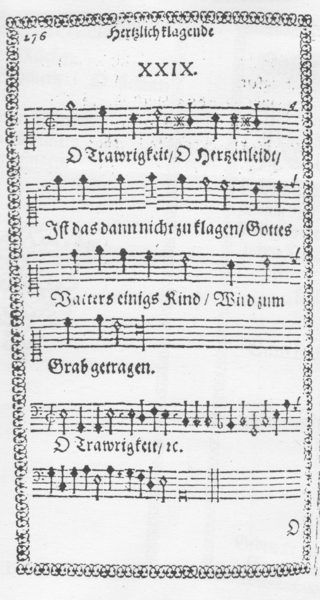Though I have rarely been called upon to play it, I have always found the Good Friday hymn ‘O sorrow deep’ (‘O Traurigkeit’ [173]) puzzling to realize as it is notated in the Hymnal. The first two phrases move in half notes; then, with a tempo indication rare in this edition of the Hymnal, the remainder, now moving in quarter notes, is to be taken ‘slightly slower’. (The change in note values is not unlike that in ‘Sonne der Gerechtigkeit’ [223], though the latter has no tempo change indicated.)
The Hymnal version is taken from that printed in Rist & Schop’s Himmlische Lieder (1641). Perusing the online Liedboek Compendium, the Netherlands Protestant Church’s counterpart to the Hymnal Companion, however, I ran across an entry treating this tune, where the original version, as found in the Himmlische Harmony Von vielerley lieblich zusammenstimmenden Frewd-

This original form of the melody has no change in either note values or tempo and thus seems less fussy to realize. Interestingly, though the author of the Compendium article suggests the hymn is usually sung too slowly, he does not mention the change in note values between the original and Schop’s revision, instead dealing mainly with the transposition(s) and key signatures, and barring and meter, of the tune in various modern books. Nevertheless the 1973 Liedboek voor de Kerken and the 1975 German Catholic Gotteslob –I have not seen the newer editions of either book – do use, nearly, the original form of the tune (both change the last note of the second phrase to a half note and the Liedboek makes two other changes).
Though it appeared in these 1970s European books, the original version of ‘O Traurigkeit’ was apparently unknown to the Hymnal 1982 Committee – or even, some several years later, to the author of the Hymnal Companion article on ‘O Traurigkeit’, who suggested that the existence of the original version was nothing more than a rumor. The Episcopal Church would do well to print this version in its next Hymnal revision; meanwhile there is nothing to prevent its use.